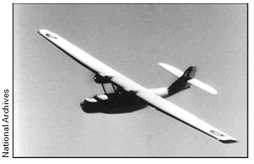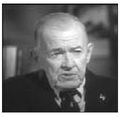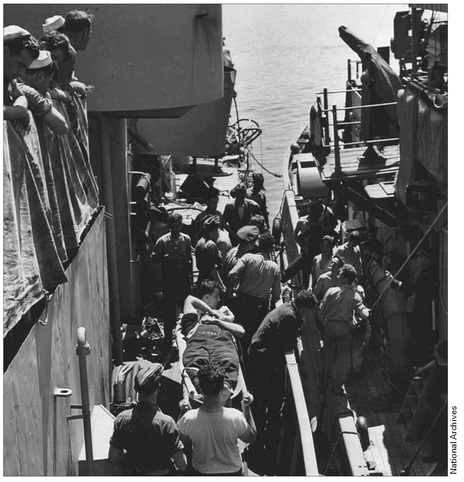War Stories III (26 page)
Authors: Oliver L. North

Petersen's assessment of how dangerous it was to serve aboard a German U-boat is borne out by the numbers. From December 1939 to the end of the war in Europe in May 1945, Dönitz deployed 830 U-boats into the Atlantic and Mediterranean. Only 134 returned. Overall, the odds were little better. Counting those deployed in the Baltic, Indian Ocean, and the Arctic approaches to Russia, Dönitz committed 1,175 U-boats to the war but lost 781 or them. Of 40,900 German U-boat crewmen, 25,870 were killed and another 4,879 were captured when their U-boats were sunk orâin three casesâcaptured.
The convoy system, initiated by the British during World War I and implemented again by the Royal Navy in World War II, eventually doomed Hitler's effort to strangle the British Isles. Though Dönitz attempted to adapt his tactics and deployment patterns to counter the Allied convoy measures, he was never able to make up for losses in U-boats and trained
crews as the U.S. and British improved their anti-submarine warfare capabilities. By May 1943, long-range variants of the American B-24 Liberator, Navy PBY-Catalina, and the British Wellington bombers made all but small areas of the mid-Atlantic deadly for U-boats and their crews.
crews as the U.S. and British improved their anti-submarine warfare capabilities. By May 1943, long-range variants of the American B-24 Liberator, Navy PBY-Catalina, and the British Wellington bombers made all but small areas of the mid-Atlantic deadly for U-boats and their crews.
German scientists invented dramatically improved magnetic and then acoustic-homing torpedoes, radar detection equipment, the
schnorkel
âair-intake devicesâand even a hydrogen-peroxide propulsion system. But by mid-1943 Dönitz was losing more U-boats than German shipyards could replace, and Allied shipbuilders were launching more than six new ships for every one sunk.
schnorkel
âair-intake devicesâand even a hydrogen-peroxide propulsion system. But by mid-1943 Dönitz was losing more U-boats than German shipyards could replace, and Allied shipbuilders were launching more than six new ships for every one sunk.
Â
Navy PBY-Catalinaâinstrumental in hunting down U-boats.

Though warships were vital, so were transport vessels. The first Liberty ship, the USS
Patrick Henry,
was launched on 27 September 1941. By 1943, eighteen U.S. shipyards on the East, West, and Gulf coasts were launching “Liberty ships” as fast as they could be welded together. Valued at $1.5 million each, Liberty-class ships were 440 feet long and could carry nearly 10,000 tons of cargo at eleven knots. Over the course of the war, 2,708 Liberty ships were builtâthe fastest going from keel to completion in just four days.
Patrick Henry,
was launched on 27 September 1941. By 1943, eighteen U.S. shipyards on the East, West, and Gulf coasts were launching “Liberty ships” as fast as they could be welded together. Valued at $1.5 million each, Liberty-class ships were 440 feet long and could carry nearly 10,000 tons of cargo at eleven knots. Over the course of the war, 2,708 Liberty ships were builtâthe fastest going from keel to completion in just four days.
To man these thousands of new vesselsâand the new tankers and coastal freighters being constructedâthe U.S. Merchant Marine put out an urgent call for able-bodied seamen. Nearly a quarter-million American men answered the callâmany of them too old to be drafted, others who had been spurned by military recruiters for poor eyesight, others who were just too young. And unlike the military, the U.S. Merchant Marine service wasn't segregated.
Those who volunteered to serve in the Merchant Marines were putting their lives on the line just as much as any soldier, sailor, airman, Guardsman or Marine. Going to sea in a Liberty ship exposed a seaman to risk of being
bombed by the Luftwaffe, sunk by a German surface combatant like the
Bismarck
, torpedoed by a U-boat, or attacked by one of Germany's ten surface raidersâdeceptively constructed to look like a merchant ship, but every bit as lethal as any warship.
bombed by the Luftwaffe, sunk by a German surface combatant like the
Bismarck
, torpedoed by a U-boat, or attacked by one of Germany's ten surface raidersâdeceptively constructed to look like a merchant ship, but every bit as lethal as any warship.
Throughout the war, the vessels most at risk of being attacked by a U-boat or a merchant raider were those that traveled alone. Though convoy operations were well underway by 1942, delays in loading, port and pier availability, and the need to deliver priority cargoes urgently were all problems that caused thousands of ships to make their transits without escorts. On 10 September 1942, George Duffy, of Newburyport, Massachusetts, the Third Mate aboard the Liberty Ship
MV American Leader,
found out just how dangerous steaming alone could become.
MV American Leader,
found out just how dangerous steaming alone could become.
GEORGE DUFFY
MV
AMERICAN LEADER
South Atlantic Ocean
10 September 1942
AMERICAN LEADER
South Atlantic Ocean
10 September 1942

I had wanted to go to the Naval Academy but failed the physical exam so I went into the Merchant Marine instead. For the first six months in the classroomâlearning mathematics, navigation, rules of the road, Morse radio code, seamanshipâyou name it. Once we got our mates licenses we were automatically ensigns in the naval reserve.
In early 1942 I was assigned as third mate on the
American Leader
, a C-1 class Liberty shipâthe smallest of the four classes. It was a little over 400 feet long, had a 27-foot draft, and could carry about 10,000 tons of cargo.
American Leader
, a C-1 class Liberty shipâthe smallest of the four classes. It was a little over 400 feet long, had a 27-foot draft, and could carry about 10,000 tons of cargo.
We left New York Harbor on 26 April 1942, with a full cargo of war supplies for the Russians and the British forces in the Middle East. We were carrying barbed wire, army boots, steel ingots, steel platesâand nine twin-engine bombers lashed on deck with all of their spare parts in the hold.
On the routing we were assigned there were no convoys and no escorts available. All we had for protection was our high speedâwe could
make eleven knotsâand firepower from our ten-man navy gun crewâusing a single 4-inch gun and two .50-caliber machine gun mounts in case of air attack.
make eleven knotsâand firepower from our ten-man navy gun crewâusing a single 4-inch gun and two .50-caliber machine gun mounts in case of air attack.
We headed first to Trinidad, where we filled up with fuelâenough to go 7,500 miles. We spent a few days there until we got clearance for the first leg of our runâall the way to Cape Town, South Africa. There, we took on more fuel and then got our routingâand once again, no escorts were availableâup through the Indian Ocean and into the Persian Gulf.
At Bandar Abbas, Iran, we offloaded all the equipment for the Russians and took on ten tons of opiumâfor making morphine back in the States. We then went up the Shatt al Arab to the British offload facility in Iraq where we discharged all their military equipment. We took on some Arab tobacco consigned to Philip Morris and headed for India, where we offloaded the steel. After that we made port in Colombo, Ceylonânow called Sri Lankaâand took on 7,000 tons of rubber and drums of latex and coconut oil.
Following the British routing instructions we made it back into Cape Town on the night of the third of September and the captain went to the admiralty office to get our routing instructions for New York while we took on fuel and made a few minor repairs. The British said that there were U-boat wolf packs operating off the U.S. coast so they routed us due west to Cape Horn, up the west coast of South America to the Panama Canal where we were to pick up an escort to New York.
We had heard about two German raiders operating in the South Atlanticâbut the British Admiral in Cape Town said they had been sunk or driven off. In these waters we were more concerned about raiders than U-boats. They were faster and better armed than U-boats and the raiders were piratesâflying anybody's flag they felt like. A raider looks like an ordinary merchant ship until it goes into action.
We got under way for Cape Horn on the night of 7 September. Three nights out of Cape Town we were making nine knots on a heading of 270 degrees, and all of a sudden, shortly after dark, up out of nowhere came
another vessel. Without warning they opened fire with deck guns and we were on fire.
another vessel. Without warning they opened fire with deck guns and we were on fire.
I ran out on deck and there were flames everywhere and this strange ship was still firing at us. Some of their 4-inch and 5.9-inch shells had exploded in the engine room and ruptured our fuel tanks and we lost all power. The lifeboats had been destroyed by the gunfire so when the order came to abandon ship, we had to throw the life rafts into the water and jump over the side into the oil that was burning on the sea.
While we were getting the rafts in the water, another shell burst burned me and caught my life jacket caught on fire. So when I went into the water, I was glad to find a life raft. Able seaman Ken Pride helped pull me into the raft and pretty soon there were twenty-three of us in this raft, sitting there in 56-degree water watching our ship burn.
She didn't sink right away because of all the rubber in the holdsâand so this ship that looks like a merchantmanâbut isn'tâfires two torpedoes into the
American Leader
to send her down and stop the fire, which could have attracted attention. Shortly after she sank, this big ship pulls up alongside and starts to pick up survivors. We were worried that it might be a Japanese shipâbut then we heard them speaking German.
American Leader
to send her down and stop the fire, which could have attracted attention. Shortly after she sank, this big ship pulls up alongside and starts to pick up survivors. We were worried that it might be a Japanese shipâbut then we heard them speaking German.
Out of a crew of fifty-eight on the
American Leader,
they rescued forty-seven of usâand that's how we learned that we had been sunk by the German raider
Michele.
We were put in the hold with almost 500 other POWsâBritish, Indian, South African, Canadian, and New Zealandersâwhose ships had also been sunk or captured by the
Michele.
I think we were their eleventh victim.
American Leader,
they rescued forty-seven of usâand that's how we learned that we had been sunk by the German raider
Michele.
We were put in the hold with almost 500 other POWsâBritish, Indian, South African, Canadian, and New Zealandersâwhose ships had also been sunk or captured by the
Michele.
I think we were their eleventh victim.
I have to say that they fed us well and gave us very good medical attentionâotherwise a lot of us would not have survived. On 29 November, the
Michele
sank another American transport, the
MV Sawokla
âbut there were only nineteen survivors from that one.
Michele
sank another American transport, the
MV Sawokla
âbut there were only nineteen survivors from that one.
We hoped that they would take us to some neutral country to be internedâbut instead they turned us over to the Japanese. That's when things really got rough.
It was quite an experience. Having started the war as a Merchant Marine officer on a Liberty ship, I got sunk by a German auxiliary raider and ended the war as a Japanese POWâdoing slave labor on a railroad in Indonesia. Nobody can tell me that life in the Merchant Marine isn't interesting.
The ten German auxiliary raiders sank or captured 138 Allied merchant ships, totaling a million gross registered tons. The
Michele
was struck by a torpedo from the American submarine USS
Tarpon
on 17 October 1943, and the surreptitiously armed merchant ship that had sent nineteen Allied vessels to the bottom was sunk herself.
Michele
was struck by a torpedo from the American submarine USS
Tarpon
on 17 October 1943, and the surreptitiously armed merchant ship that had sent nineteen Allied vessels to the bottom was sunk herself.
German raiders like
Michele
preferred unescorted merchantmen as targets. No Allied vessel in a convoy was ever attacked, sunk, or captured by a lone auxiliary raider. Forays by major German capital ships like
Bismarck
or
Tirpitz
were certainly threats to convoysâbut so rare that losses in such action are remarkable only because there were so few.
Michele
preferred unescorted merchantmen as targets. No Allied vessel in a convoy was ever attacked, sunk, or captured by a lone auxiliary raider. Forays by major German capital ships like
Bismarck
or
Tirpitz
were certainly threats to convoysâbut so rare that losses in such action are remarkable only because there were so few.
Attacks on merchant shipping by Luftwaffe aircraft were likewise most effective against unescorted vessels. Though a large number of slow-moving merchantmen all within a confined sea-space might seem an attractive target, the escorting warships with effective radar and anti-aircraft guns increased the risk to the attacking aircraft.
It was the same for the U-boats. Though “wolf pack” attacks on convoys sound ominous, the numbers show otherwise. The majority of the Allied merchant vessels sunk were not in protected convoys, but were mostly single ships crossing alone.
The challenge then for the Britishâand the Americans after Pearl Harborâwas to find enough well-armed escorts to economically organize and protect the convoys plying the routes across the Atlantic. Battleships, cruisers, and destroyers had far too many other tasks and were too few in number to be employed exclusively in convoy duty.
The best ships for the job were smaller, lightly armored vessels, equipped with sonar, radar, and an effective suite of anti-aircraft and anti-submarine weapons. Based on a British design, the Americans called them “destroyer escorts”âand they became the guardians of the Atlantic convoys, crucial to eliminating the U-boat threat.
Â
The dead and wounded are transferred from the USS
Menges
after the ship was struck by a German torpedo.
Menges
after the ship was struck by a German torpedo.

Other books
Canyon Secret by Patrick Lee
Charitable Hearts by EJ McCay
Book of Secrets by Chris Roberson
Red Sky at Dawn by D. A. Adams
Temporary Perfections by Gianrico Carofiglio
A Cowboy Firefighter For Christmas (Smokin' Hot Cowboys 1) by Kim Redford
Survivor Planet III by Juliet Cardin
Savage Summer by Constance O'Banyon
Christmas Haven by Hope White
Fifty Shades of Grey by E. L. James
